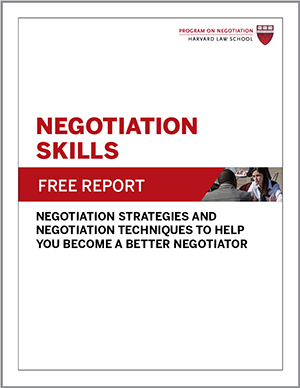
When thinking of negotiation in international relations, it’s difficult to think of any negotiation with higher stakes than those surrounding nuclear nonproliferation. Often conducted amid international conflict and public scrutiny, complicated by language and cultural barriers, and carried out under tight deadlines, talks aimed at ensuring that nuclear technology is used peacefully and that disarmament procedures are followed closely demand the highest level of diplomacy and negotiation skills.
Speaking at the Program on Negotiation (PON) at Harvard Law School in February 2015, Laura Rockwood, then the executive director of the Vienna Center for Disarmament and Non-Proliferation, offered hard-won advice on negotiation in international relations from her decades of negotiating, interpreting, and implementing safeguards for the International Atomic Energy Agency (IAEA).
When she joined the IAEA as a legal officer in 1985, Rockwood felt challenged on numerous levels. “I was young, female, and culturally and educationally American—in the middle of a foreign, multicultural, predominantly male environment,” she said at the PON event, “responsible for providing legal counsel on a subject about which I knew nothing at the time.” Forced to learn on the job after her more-senior partner in the safeguards division retired, Rockwood said, “Any number of evenings, I went home in fear that I might start World War III.”
The IAEA is an independent intergovernmental organization founded in 1957 to (1) promote safe uses of nuclear energy, (2) help developing countries use nuclear techniques for environmental and medical applications (such as pest eradication and cancer treatment), and (3) institute safeguards to verify states’ compliance with legally binding obligations not to misuse nuclear material, equipment, or facilities for nuclear weapons.
Rockwood was the lead safeguards attorney in the IAEA’s Office of Legal Affairs. She oversaw the agency’s verification role shift from oversight to a more investigative approach, as highlighted by the pivotal role of IAEA weapons inspectors during and after the 1990–1991 Gulf War. She also led negotiations among IAEA member states and its Board of Governors for a new nonproliferation legal instrument.
World War III did not break out on Rockwood’s watch. Indeed, the IAEA received the Nobel Peace Prize in 2005, during her tenure.
Throughout her PON talk, Rockwood detailed several diplomatic negotiation techniques that she and her colleagues used to achieve breakthroughs in some of their most intense negotiations, including those involving the nuclear programs of Iraq, Iran, and Libya, and a post–Cold War disarmament initiative negotiated with the United States and Russia.
Listening to Learn
Beginning in 1996, Rockwood led two years of trilateral negotiations among the United States, Russia, and the IAEA to reach agreement on the permanent removal of fissile material from the former enemies’ weapons programs.
During the international negotiations, Rockwood witnessed a technique that she found to be “incredibly simple,” “extraordinarily successful,” and beneficial to all parties involved. At the PON event, she described it in the context of negotiation in international relations:
Here’s how it works. The Russian negotiator would convey the views of his government. The U.S. negotiator would say, “Let me see if I understand what you’re telling me.” He would then proceed to synthesize the Russian government’s position—honestly, fairly, and without coloring it with the U.S. position. When the Russian negotiator nodded agreement with that understanding, the U.S. negotiator would say, “OK, then. Let me explain why my government has a difficulty with that position.”
That type of formalized active-listening process can include repeating back what someone has said to check your understanding, asking open-ended clarification questions, and identifying and acknowledging the other party’s concerns. Notably, articulating where disagreement may lie follows only after you fully understand the other side’s stance.
The technique has at least three benefits, according to Rockwood: (1) It shows the person across the table that you’ve listened to them, (2) it demonstrates that you understand their position as they articulated it, and (3) it conveys your or your organization’s own position “by focusing on the issue, not by personalizing the difference or by demonstrating power, ego, or anger.”
Rockwood noted that as “broken English” has become the lingua franca of negotiation in international relations, misunderstandings are common. For example, the French use the same word, sécurité, for two very different—and crucial, in IAEA negotiations—English words, safety and security, she said. Because active listening enhances understanding, it can be particularly effective when negotiating through interpreters or when one of the parties is negotiating in a foreign language, according to Rockwood.
Constructive ambiguity involves deliberately replacing “loaded” words and terms with more benign language.
During many of the bilateral and multilateral negotiations she led with IAEA member states, many governments were initially “downright skeptical” about the organization’s proposals. By “truly listening to their concerns,” Rockwood and her team were able to gain their trust and learn important information that contributed to key modifications to proposals. Thus, active listening not only helps keep negotiations civil but also can “make your product even more useful and attractive,” according to Rockwood.
Choose Your Words with Care
Typically the most challenging aspect of multiparty negotiations, whether international or domestic, is reaching consensus among the parties involved, a challenge that increases exponentially with the number of parties at the table. When consensus seems elusive, Rockwood advises business negotiators to borrow a technique from the nuclear nonproliferation world known as constructive ambiguity. Constructive ambiguity involves deliberately replacing “loaded” words and terms with more benign language.
Rockwood gave an example of a well-timed use of constructive ambiguity:
In our first reports to the IAEA Board in 2003 on Iran’s nuclear program, instead of describing Iran’s actions as “noncompliance,” we used the formulation “failed to meet its obligations under its Safeguards Agreement.” Why? Given the difference of views among IAEA member states about the consequences of using the word noncompliance—specifically, whether reporting a finding by the board of noncompliance to the United Nations Security Council was mandatory or discretionary—I believe the IAEA’s director general did not wish to prejudice the results of the board’s deliberations, derail negotiations with Iran, or engage in a lengthy collateral debate about the consequences of the use of what some considered a “politically loaded” word.
When standing by a rigid legal position could lead to self-defeating consequences, said Rockwood, “identify your real objective and consider reframing your position, or find other ways of achieving that objective.”
More advice on negotiation in international relations from Laura Rockwood:
-
Choose negotiators carefully. “Never underestimate the importance of individuals” who can “set a tone of trust and empathy without conceding negotiation points,” as opposed to those “who can make agreement in even the most straightforward negotiations impossible.”
-
Keep sensitive negotiations as private as possible. As the United States and Iran tried fruitlessly to negotiate an agreement regarding Iran’s nuclear program in 2005, one of the Iranian negotiators said to Rockwood, “Ah, Laura, we have made it much more difficult to negotiate away any of our enrichment program: We made it a matter of national pride.”
What advice would you add for negotiation in international relations?




